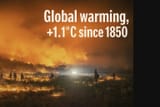Search Results
7/7/2025, 7:37:19 AM
As justification for their climate crisis hysteria, liberals keep insisting that average global temperatures have risen, with the most commonly cited figure being a 1.1°C to 1.3°C (2.0°F to 2.3°F) increase since the pre-industrial era (1850–1900). The National Oceanic and Atmospheric Administration (NOAA), however, begins its “reliable” records in 1880 and reports an increase of about 1.1°C (2.0°F) since then. Even NOAA acknowledges the limitations of early data, stating, “Earth’s surface temperature has risen about 2 degrees Fahrenheit since the start of the NOAA record in 1850.”
But these claims rest on flawed foundations. Ninety-six percent of U.S. temperature stations fail to meet NOAA’s own siting standards and are often surrounded by development, resulting in inflated readings from the urban heat island effect. The transition from mercury thermometers to digital sensors between the 1980s and 2000s introduced discontinuities in the data, right during the period of supposed accelerated warming. Early measurements were geographically concentrated in Europe and North America, ignoring vast regions, especially the 71% of the planet covered by oceans.
Measurement errors of ±0.5°C often exceed the very climate signals being used to justify sweeping policy changes. Worse still, much of the raw data has been adjusted or “homogenized” using subjective assumptions that can introduce as much bias as the trends being studied.
https://www.thegatewaypundit.com/2025/07/flaws-150-years-global-temperature-data-blow-holes/
But these claims rest on flawed foundations. Ninety-six percent of U.S. temperature stations fail to meet NOAA’s own siting standards and are often surrounded by development, resulting in inflated readings from the urban heat island effect. The transition from mercury thermometers to digital sensors between the 1980s and 2000s introduced discontinuities in the data, right during the period of supposed accelerated warming. Early measurements were geographically concentrated in Europe and North America, ignoring vast regions, especially the 71% of the planet covered by oceans.
Measurement errors of ±0.5°C often exceed the very climate signals being used to justify sweeping policy changes. Worse still, much of the raw data has been adjusted or “homogenized” using subjective assumptions that can introduce as much bias as the trends being studied.
https://www.thegatewaypundit.com/2025/07/flaws-150-years-global-temperature-data-blow-holes/
Page 1
